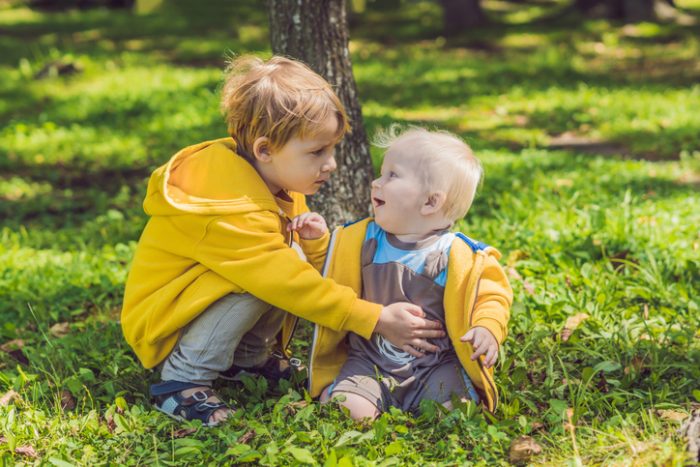As parents, one of our main goals is to help our children develop an understanding and empathy for other people. If you are the parent of a toddler, you know that instilling this idea of empathy seems an almost impossible task. There’s a good reason for that–it is almost impossible for a toddler. Most of us know that toddlers (under about 4 years of age) simply don’t have the cognitive or social-emotional development skills to understand what other people might be feeling or thinking–an aspect of social skills known as perspective-taking.

This task is what psychologists call Theory of Mind–that is the ability to understand or anticipate what another person is feeling or thinking. In other words, it’s the ability to put yourself in someone else’s shoes. This is part of a set of social skills that is the basis for empathy but also is crucial in children learning things like sharing and helping others.
At What Age Do Children Develop Perspective Taking?
So how do children learn this important skill of taking another person’s perspective? Researchers have long believed that this ability develops in most kids around 4 years of age. This video gives a great example of the difference between a 3 and 4-year-old in perspective-taking ability (also called Theory of Mind):
After viewing this video, it’s almost as if something magical happens between ages 3 and 4 that helps kids learn this skill. In a sense, this is true. Children’s brains are constantly changing and making new circuits that make new thought processes possible. However, new research is showing that how parents talk to their children may also aid in this perspective-taking ability.
Perspective-Taking: Words Matter
A study published in the journal Child Development showed that children whose parents described more about how other people might be feeling or thinking had better perspective-taking skills than those whose mothers or fathers did not use this descriptive language.
In some respects, this study seems kind of obvious. You would expect that talking to a child about taking another person’s perspective would help them learn this ability. When you really consider this, though, it is pretty amazing. The cognitive skill it takes for a youngster to understand the perspective of another person is pretty complex, and to think that just a parent talking to them about this influences how quickly they learn this skill.
The other compelling aspect of the study is the finding that children who had delays in language acquisition also had delays in perspective-taking ability. This provides further evidence that the link between language and perspective-taking ability is a real one. The researchers believe that specific aspects of language acquisition (e.g., learning possessive words) help children gain the cognitive flexibility needed to take another person’s perspective.
How Do You Practice Perspective Taking?
- Point out other children’s emotions when you see them.
Even young children are very aware when other kids get hurt or are upset. Does your child notice or seem concerned when she hears another child crying? Use this as a learning opportunity–talk to your child about how the other child might be feeling. For example, you could ask, “Why is that little boy sad? Do you think he is sad or angry? What do you do when you are sad?”
- Books can teach lessons.
Kids tend to notice small details about social skills and perspective-taking in books that we might miss. They often ask things like, “Why is that bear sad?” or “Why is that girl laughing.” Take advantage of these situations and explain the emotions you are seeing in the story.
Check out this online bookshelf for resources on toddler emotional development.
- Talk about emotions at home.
Parents have mixed feelings about showing too much emotion in front of kids. We sometimes like to put up a “strong front” and not let our kids see us cry or feel sad. Sometimes, there is some value to this—we don’t want to burden our kids with issues that may not be appropriate for their developmental level. However, it’s not burdensome to let our kids see us as emotional beings from time to time. When we experience the loss of a loved one or are worried about a friend, our kids will probably notice our change in mood. If they ask, you can take the time to explain why you are sad (in kid-appropriate terms). This might give them a bit more insight and empathy for your feelings and those of others.
- Focus on setting boundaries on behaviour, not emotions.
As this article points out, one key to effective parenting is setting boundaries and limits on their behaviour, not their emotions. Allow kids the emotional freedom to feel how they feel, even if it’s ugly at times (hello,tantrum). Research continues to show that the most effective parents don’t induce guilt trips or psychological tricks. Rather, you can set a firm limit on behaviour and help kids cope with the emotions that may follow. Over time, this experience with authentic emotion (and guidance from you) will help them understand the emotions of others.
- Pretend play and role play.
Young children love pretend play and it just so happens it is a great way to encourage perspective-taking skills. Think about it—when a child pretends to be another person or character, they have to understand (at least a bit) that person’s feelings and actions. This is perspective-taking in action! They are literally putting themselves into someone else’s shoes to pretend to be that person. Encourage and foster pretend play in young children in any way you can. You might ask your preschooler how the person they are pretending to be would feel or act in different situations. Fun and learning are all wrapped in one activity!
Despite everything you can do to help your child learn perspective-taking, it is worth noting that a child does still have to have a certain degree of cognitive development in order to foster perspective-taking and empathy. No matter how much you talk to your 2-year-old about how another person is feeling, they most likely are not going to really understand the other person’s perspective. This use of description language, however, will hopefully help your child later when they have the cognitive maturity to grasp the idea of taking another person’s perspective.
Source: we have adapted this article and video from an article on the Thoughtful Parent blog.
